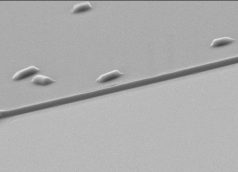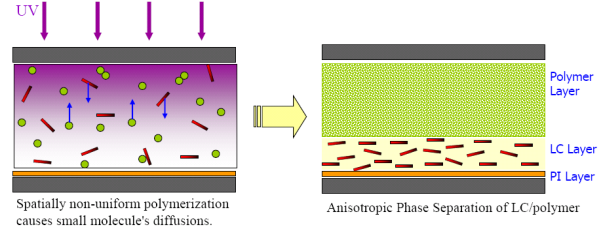
|
An anisotropic phase separation process initiated by a UV irradiation intensity gradient along substrate normal can result in complete separation of liquid crystal and polymer and form adjacent parallel layers of LC and polymer (referred as PSCOF). Such a unique bi-layer structure can be used to fine-tune optic path of LC cells, build fast-switching cell with very thin LC film, and fabricate plastic LC display with uniform cell spacing control. To prepare PSCOF cells, one can start with a mixture of LCs and photo curable monomers which is very similar with those people used to make PDLC. Expose to collimated UV light from one side of the cell. The strong absorbance of UV by LC molecules can produce a large UV Intensity gradient along the substrate normal, which results in a non uniform polymerization rate of monomers. Close to the UV† source, the light intensity is stronger, and polymerization proceeds faster, monomers will migrate from the bottom of the cell through diffusion. While the LC molecules are expelled out from polymerized volume and move toward the bottom. At the end of polymerization, a complete separation of LC and polymer forms adjacent parallel layer structure, the optic axis of LC layer can be controlled by a rubbed polyimide surfaces which is in contact with LC layer. |
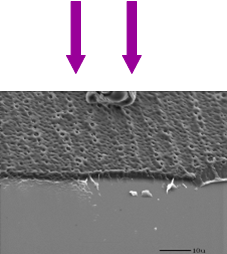
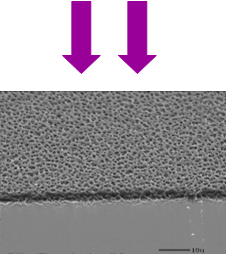
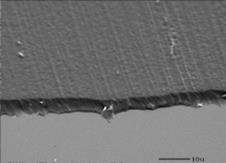
|
UV Light |
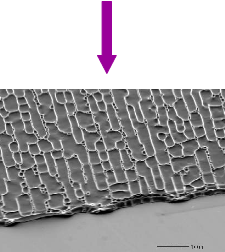

|
The final polymer/LC structure in a PSCOF cell is determined by the competition of two processes: ∑ Polymerization of monomers ∑ Diffusion Process of small molecules (small monomers and LC molecules) Fast polymerization and slow diffusion result in heterogonous PDLC-Like structures due to large portion of LC materials failed to diffuse out of the polymerized polymer volume. |
Fast-Switching PSCOF devices
PSCOF method can be used to achieve in-situ cell gap reduction and fabricate LC devices with very thin LC film without using spacers of that size. PSCF LC cells with less than 1 micron LC film thickness had been prepared and the switching time can be as fast as less than 1 millisecond. |
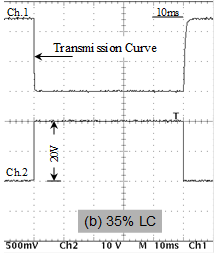
Flexible LCD with Polymer-Embedded-Spacer Structure
One of the most challenge for flexible plastic LCD using traditional fiber or bead spacers is difficult to maintain uniform cell spacing control. Spacers in plastic LC cells tend to move around or aggregate together, especially when the cell is temporally deformed under pressure.† We designed a polymer-embedded-spacers structure in plastic LC cells using PSCOF method. A uniform solidified polymer layer can strongly hold the spacers and fixed them at their initial position, prevent the spacers from moving or migrating even under external press, thus improve the uniformity of plastic LCDs. |
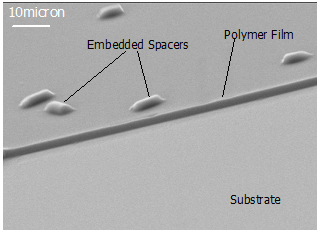
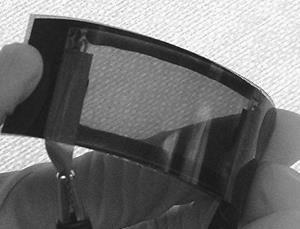
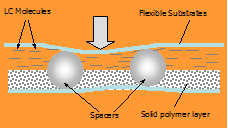
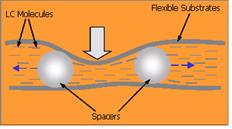
Publications And presentations
1. Method for fabrication of liquid crystal cells with narrow gap, fast switching, and flexible plastic substrates, Q. Wang, R. Guo and S. Kumar, Invited Article, J. Soc. Information Display, 14, 545 (2006). 2. Control of polymer structures in phase-separated liquid crystal-polymer composite systems, Q. Wang, J.-O. Park, M. Srinivasarao, L. Qiu, S. Kumar, Japn. J. Appl. Phys. 44, 3115, (2005). 3. Display and non-display applications of the phase-separated composite films method, Q.-B. Wang, R. Guo, J.-H. Kim, S. Kumar, Proc. 33rd Topical Meeting on Liq. Cryst., Paderborn, Germany, p 23, (2005). 4. Formation and Localization of Internal Polymer Columnar Structures in Liquid Crystal Cells, Q. Wang, L-C. Chien, and S. Kumar, Appl. Phys. Lett 83, 3698 (2003). 5. Different Limits of Phase Separation and Their Applications, Q. Wang, B. Acharya, H.-C. Choi, J.-H. Kim, and S. Kumar, Proc. SPIE 5003, 81 (2003). 6. New Type of LCD With a Single Glass Substrate, Il Kim, J.-H. Kim, D. M. Agra-Kooijman and S. Kumar, SID Digest XXXIII, 574 (2002). 7. Phase Separated Composite Films of Liquid Crystals, V. Vorflusev, J. H. Kim, and S. Kumar, Pramana- J. Phys., 53, 121 (1999). 8. Phase Separated Composite Films: Experiment and Theory, T. Qian, J.-H. Kim, S. Kumar, and P.L. Taylor, Phys. Rev. E 61, 4007 (2000). 9. Flexible Displays Prepared Using Phase Separated Composite Organic Films of Liquid Crystals, J. H. Kim, V. Vorflusev, and S. Kumar, SID Digest 30, 880 (1999). 10. Phase Separated Composite Films for Liquid Crystal Displays, V. Vorflusev, and S. Kumar, Science 283, 1903 (1999).
|
|
1. Phase Separated Composite Films (PSCOF) |
